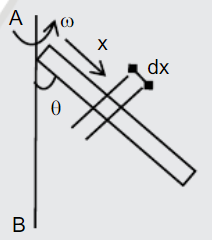A solid body rotates about a stationary axis so that its angular velocity depends on the rotation angle φ as ω=ω0−aφ, where ω0 and a are positive constants. At the moment t=0 the angle φ=0. Find the time dependence of
(a) the rotation angle,
(b) the angular velocity.
We have ω=ω0−aφ=dφdt
Integration this Eq. within its limit for (φ)t
φ∫0dφω0−kφ=t∫0dt or, 1nω0−kφω0=−kt
Hence φ=ω0k(1−e−kt) (1)
(b) From the Eq., ω=ω0−kφ and Eq. (1) or by differentiating Eq. (1)
ω=ω0e−kt
Topper's Solved these Questions
- BOOK - IE IRODOV, LA SENA & SS KROTOVCHAPTER - PHYSICAL FUNDAMENTALS OF MECHANICSEXERCISE - The Fundamental Equation Of Dynamics59videos
PHYSICAL FUNDAMENTALS OF MECHANICS
- BOOK - IE IRODOV, LA SENA & SS KROTOVCHAPTER - PHYSICAL FUNDAMENTALS OF MECHANICSEXERCISE - Laws Of Conservation Of Energy, Momentum And Angular Momentum82videos
PHYSICAL FUNDAMENTALS OF MECHANICS
- BOOK - IE IRODOV, LA SENA & SS KROTOVCHAPTER - OSCILLATIONS AND WAVESEXERCISE - Electromagnetic Waves, Radiation36videos
OSCILLATIONS AND WAVES
- BOOK - IE IRODOV, LA SENA & SS KROTOVCHAPTER - THERMODYNAMICS AND MOLECULAR PHYSICSEXERCISE - Transport Phenomena38videos
THERMODYNAMICS AND MOLECULAR PHYSICS
Similar Questions
Angular momentum of a rigid body rotating about a fixed Axis with angular velocity →ω
View SolutionA solid body rotates with deceleration about a stationary axis with an angular deceleration β∝√ω, where ω is its angular velocity. Find the mean angular velocity of the body averaged over the whole time of rotation if at the initial moment of time its angular velocity was equal to ω0.
View Solution
Knowledge Check
- Question 1 - Select One
A solid body rotates about a stationary axis so that its angular velocity depends on the rotational angle ϕ as ω=ω0−kϕ where ω0 and k are positive constants. At the moment t = 0, ϕ=0, the time dependence of rotation angle is
Akω0e−ktBω0ke−ktCω0K(1−e−kt)Dkω0(e−kt−1) - Question 2 - Select One
A solid body rotest about a stationary axis, so that its angular velocity depends on the rotational angle ϕ as ω=ω0−kϕ where ω0 and K are postitive constatns. At the moment t=0,ϕ=0 Find the dependence of rotaions angle.
Akω0e−ktBω0ke−ktCω0k(1−e−kt)Dkω0(e−kt−1) - Question 3 - Select One
A solid body rotates about a stationary axis so that its angular velocity depends on the rotation angle as = 0 – k , where 0 and k are positive constants. At the moment t = 0, the angle = 0. Find the time dependence of rotation angle -
AK.ω0e−KTBω0K[e−Kt]Cω0K[1−e−Kt]DKω0[e−Kt−1]
A solid body starts rotating about a stationary axis with an angular acceleration β=β0cosφ, where β0 is a constant vector and φ is an angle of rotation from the initial position. Find the angular velocity of the body as a function of the angle φ. Draw the plot of this dependence.
View SolutionA solid body rotates about a stationary axis so that its angular velocity depends upon the rotation angle ϕ as ω−ω0=aϕ, where a and ω0 are positive constants. Initially that is at t =0,ϕ=0.
View SolutionA rod is rotating with angular velocity ω about axis AB. Find cosθ.
 View Solution
View SolutionA solid cylinder of mass M and radius R rotates about its axis with angular speed ω. Its rotational kinetic energy is
View SolutionA solid sphere is rotating with a constant angular velocity about an axis touching the surface. Its angular momentum will be:
View Solution
